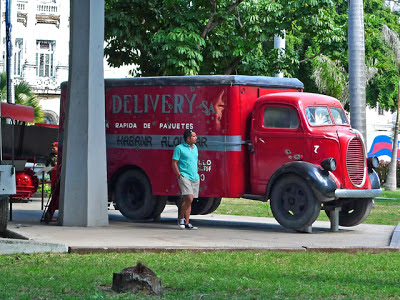 |
| Ford COE (cab-over-engine) truck carried rebels to Batista's palace. |
When I look at the Ford truck at the Granma Memorial, I too think about history and assassinations. But here, I wonder how events might have unfolded had an attempt to kill a president not failed, but succeeded.
It was Wednesday, March 13, 1957, when the red van, 20 years old and still bearing in Spanish and English the markings of the delivery company that once owned it, pulled up at the Presidential Palace in Havana. On this day it was delivering 42 armed men, part of a force intent on removing Fulgencio Batista and restoring Cuba's constitutional government.
The attack was orchestrated by a young firebrand named José Antonio Echeverría, whose Directorio Revolucionario group was only loosely aligned with Fidel Castro's 26th of July Movement. Echeverría had not consulted the bearded guerrilla on his plan to kill Batista.
| Bullets pierced every side. |
The student leader himself was not at the palace but blocks away with another force outside the studios of Radio Reloj, which he intended to occupy so he could broadcast the news that Batista's regime was toppled.
Had the gunmen found Batista in his second-floor office, they surely would have killed him. But the dictator had left the room not long before, taking a private elevator that was the only access to his family's quarters on the third floor. The palace guards, regrouping after the surprise assault, pushed back the attackers. Menelao Mora died on the palace's marble staircase and others fell in the gun battle that went on for hours outside.
Echeverría seized the radio station and made his announcement, but whether anyone heard it is uncertain. One report suggests the feed was cut before he reached the microphone; another that the young rebel in his excitement spoke so loudly that the broadcast was muted by the station's automatic level controller.
His failure would be complete. Leaving the station for the nearby university, the rebels were blocked by a police car. Echeverría, 24, began firing and was struck by a police bullet. He died in the street, just steps from the famous staircase that leads to the campus.
 |
| Plaque honours three of the fallen. |
A bloodbath indeed, but one that would greatly advance Castro's own efforts, even if he had no part in the attack. Two of his Havana rivals were gone, and Batista, despite the bravura he would show in the following days, was shaken. The course for the dictator's eventual abdication, and Castro's takeover, was set.
But what if Batista had been killed that day? Would a democratic government have resulted? And endured? Would Cuba today be another quiet nation of sunshine and commerce like Costa Rica or the Bahamas?
Or would Castro, already a folk hero to many Cubans, have found a place in the new government and then, gradually or quickly, taken control? Would the socialist reforms that he and Che Guevara had so long planned have swept Cuba anyway, locking the island in a decades-long standoff with its huge neighbour to the north? Would history, as Stephen King might suggest, stubbornly resist taking any other path?
Don't look for answers from the red truck, its flanks scarred by bullet holes. It speaks only of what happened that day, and not of what might have been.
 |
| Built in the late 1930s, the truck had been owned by a delivery service. |